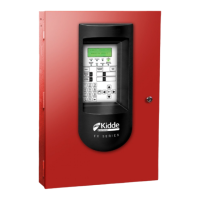Appendix C: Applications
224 P/N 3102352-EN • REV 005 • ISS 28DEC18
• Audible devices not located within-suites or dwelling units
Figure 61 on page 223 illustrates these requirements in a sample residential occupancy
building with five floors. The illustration shows that:
• Separate audible signal circuits are provided for each floor
• Audible signal circuits 2, 4, 6, 8, and 10 are located inside dwelling units
• Audible signal circuits 1, 3, 5, 7, and 9 are located in hallways not within dwelling units.
Correlations
To enable in-suite auto signal silence, you need at least ‘N+2’ correlation groups, where N =
the number of floor areas. You need: A correlation group for each floor, a hallway correlation
group, and an “in-suite” correlation group. The following tables show the inputs and outputs for
these groups.
To create correlations for in suite signal silence:
1. Create a set of correlations for each floor.
2. Create a single hallway correlation to control hallway sounders on all floors.
3. Create a single in-suite correlation for all floors to turn off sounders inside dwelling units on
all floors except the floor of alarm.
Details of each step are described below.
Creating a set of correlations for each floor
Referring to the tables below, create a set of correlations — one for each floor. While the
example given here is for a five-story building, you can adapt it to fit the number of separate
floors (or other areas) in your application. Create one correlation for each floor (or area). These
correlations ensure that if an alarm is detected on the floor, sounders located in dwelling units
on the same floor will sound.
On each floor, link all input devices on the floor (both inside dwelling units and in hallways) to
the sounders inside dwelling units on the same floor.
Notes
• Set the alarm activation count for each floor correlation to 1.
• Do not enable in-suite signal silence.
Floor 1 Correlation
Output
No in-suite
signal silence
Floor 1 dwelling and hallway inputs
Floor 1 dwelling and hallway audibles

